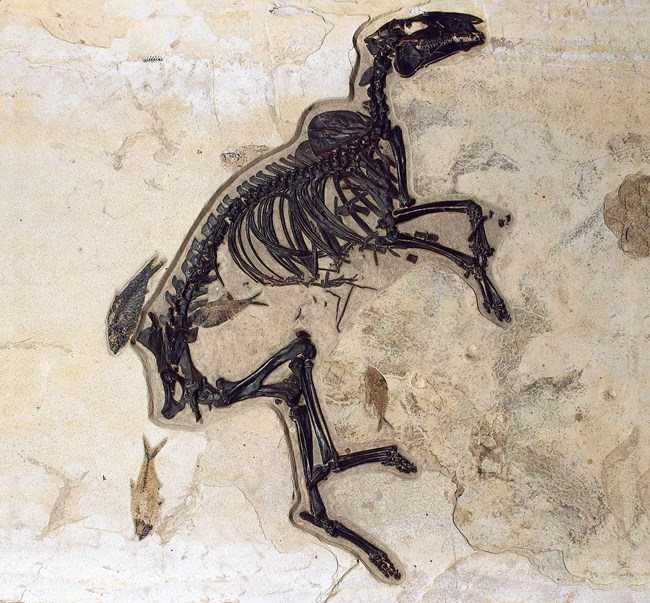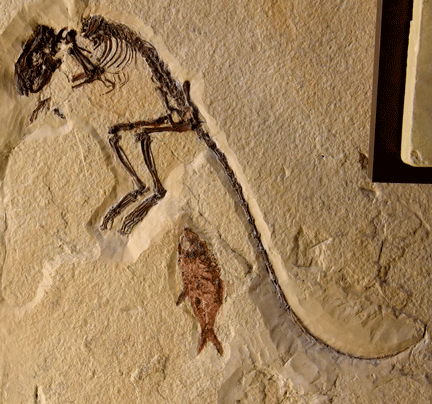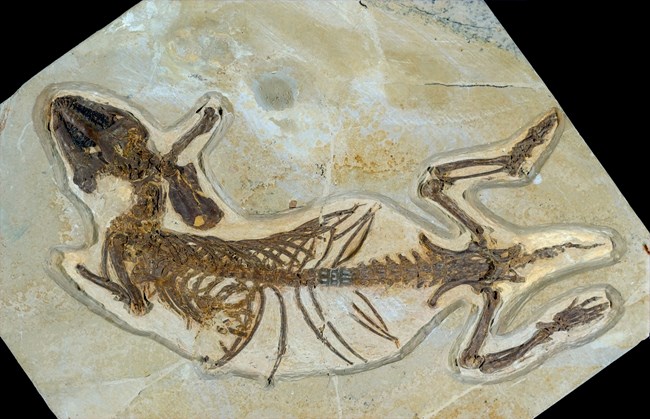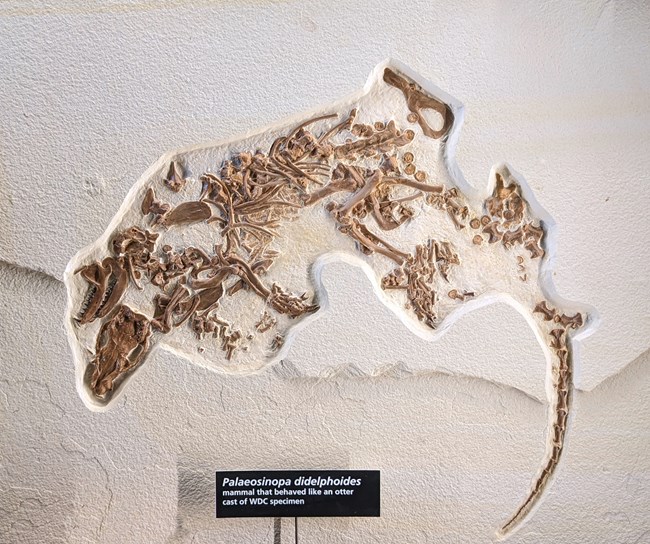|
The mammal fossils from the Fossil Butte Member (FBM) help us understand the what environment surrounding Fossil Lake was like 52-million years ago. See what mammal fossils are on display in our visitor center exhibits. 
NPS Photo Bats - 3 Species Identified: Onychonycteris finneyi, Icaronycteris index & Icaronycteris gunnelliOrder Chiroptera
O. finneyi is currently the most primitive bat discovered, a link between modern bats and their non-flying ancestors. Its primitive features include claws on each of its 10 wing digits (fingers), unlike other extinct and living bat species. These claws suggest that this species, using all four limbs, would have been an excellent climber. O. finneyi also has primitive development of the echolocation trait, suggesting this species may have been diurnal (active during the day) instead of nocturnal (active at night). Most modern bat species are nocturnal (active at night) and have small eyes with poor eyesight. This requires bats to use echolocation to track their prey. This involves bats emitting ultrasonic sounds to produce echos, similar to a radar system. The ear morphology of O. finneyi suggests this species did not use echolocation to track prey such as insects. However, the trait may have been used to sense trees or hills. I. index is more closely related to modern bats than O. finneyi. Ear morphology suggests this species had developed the use of echolocation. This species also lacks claws on its wing digits, except for one claw on the index finger and one on the thumb. One specimen has been discovered with a small fish scale preserved in the stomach, suggesting I. index fed on both insects and fish. Icaronycteris gunnelli. has been recently described and more research needs to be completed to determine its ability to echolocate and its relationship in bat evolution. The family Icaronycteridae appears to have gone extinct during the middle Eocene. For links to research articles on the bats of Fossil Lake, visit our Scientific Publications page. 
NPS Photo Odd-Toed Ungulates (Hoofed Mammals) - 2 Species Identified: Protorohippus venticolus & Lambdotherium popoagicumOrder Perissodactyla
So far, only 2 P. venticolus specimens have been found from the FBM. One specimen was found in nearshore deposits and the other in mid-lake. The specimen discovered in mid-lake deposits (pictured here) is currently the most complete skeleton of a dawn horse ever discovered. Scientists are unsure how this non-aquatic species ended up in the middle of Fossil Lake. If the specimen was fleeing a predator, it may have fled into the lake or crossed a river feeding into the lake and been swept into the middle of Fossil Lake and drowned. The FBM specimen pictured measures 33 centimeters tall (13 inches) at the shoulder. This specimen is believed to be a full grown adult. It has four small hoofed toes on its two front limbs, and three on its back limbs. Its long head, slim body, and long hind legs, all indicate this species was a strong jumper. 
NPS Photo Lemur-Like Mammal - Apatemys chardiniOrder Apatotheria, Family ApatemyidaeSo far, only one specimen of this species has been discovered from the FBM. This FBM fossil is currently the most complete skeleton of this species known in the world. The order Apatotheria appears to have gone extinct sometime during the Oligocene, and is known for fossils in both Europe and North America. Most species of this order are known only from isolated teeth and jaws. A. chardini appears to have feet and claws adapted for grasping, in addition to a long tail. These traits are characteristic of tree-living animals. This fossil is not on display. 
NPS Photo Tube-Sheep - Hyopsodus wortmaniOrder Condylarthra, Family HyopsodontidaeOnly one specimen of this species has been discovered from the FBM so far. It may be the most complete skeleton from the family Hyopsodontidae to ever be discovered. Most species in this family are known only from isolated teeth jaw fragments. They range from the size of a small rat to a raccoon. The FBM species possessed a strong chest, claws, and short limbs. These are all indicators of a mammal who commonly dug or rooted for food. The teeth suggest an omnivorous diet, feeding on both plants and small animals. This species' narrow body structure led to the common name, tube-sheep. 
NPS Photo Otter-Like Carnivore - Palaeosinopa didelphoidesOrder Pantolesta, Family PantolestidaeThree skeletons of this species have been discovered from nearshore deposits of the FBM, one with fish bones and scales preserved in the stomach. It had strong pectoral muscles adapted for swimming. The large, strong feet and tail are similar to those found on modern otters. However, P. didelphoides and modern otters are not related and arise from separate lineages. This is an excellent example of convergent evolution, where species of different lineages develop similar traits from living in similar environments and occuping similar ecological niches. |
Last updated: September 26, 2025
